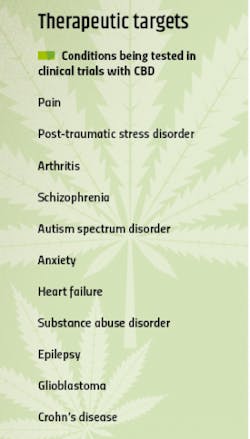No single molecule has likely ever generated as much buzz in the wellness market as CBD.
Cannabidiol — commonly known as CBD — is one of the primary, non-psychoactive compounds found in the cannabis plant. A recent loosening of regulations for CBD has triggered an explosion of over-the-counter dietary supplements touting so many therapeutic uses for the molecule, it almost sounds magical.
Not long ago, cannabis products were widely viewed as a threat to the pharma industry, partly because of the competition they could pose within key therapeutic areas such as pain management. But these days, the smoky cloud of suspicion around marijuana and its derivatives has begun to clear, and pharma companies are getting poised to take a hit off the high-growth industry of CBD.
But even prior to new rules on the federal level, CBD sales were booming in parts of the country where marijuana is legal. In February, analysts at Cowen, a Wall Street investment firm, estimated that Americans spent about $2 billion on CBD products in 2018, mostly to treat anxiety, pain or sleep issues. By 2025, they predict that the market value will swell to $16 billion, partly fueled by rising beliefs in the effectiveness of cannabis compounds.
“In the 90s, when you read stories about it, the words ‘medical cannabis’ were always put in parentheses. But I don’t think there’s any question about the medical benefits of cannabis anymore,” explains Philippe Lucas, vice president of global patient research and access at Tilray, one of Canada’s biggest medical and recreational cannabis companies. “What I have seen over the last few years is that there is now a general acceptance of the overall comparable safety of cannabis, especially when compared to opioids, benzodiazepines and even OTC drugs.”
In 2017, around 191 million prescriptions were written in the U.S. for opioids. Because many CBD users are looking for alternatives to prescription pain medications, the opportunity for that segment of the market alone is enormous.Naturally, pharma companies have taken notice of the potential of CBD. In 2018, the U.S. Food and Drug Administration approved the first pharmaceutical drug with CBD as a primary component. According to ClinicalTrials.gov, there are now about 100 studies underway examining the impact of cannabinoids, the class of cannabis compounds that includes CBD, on a wide range of ailments — from heart disease to central nervous system conditions.
Yet, to a large extent, cannabis remains on the fringes of the pharma world. But there are signs that could be changing.
Last year, Sandoz dove into the space when it struck a development and marketing agreement with Tilray — the first deal of its kind between a Big Pharma company and a cannabis partner, and a sign of a turning point between the two industries. More deals are likely on the way. All throughout the CBD supply chain, scores of companies — from drug development to delivery — are readying themselves to hook up with pharma’s top dogs so they can jointly cash in on the growing “green rush.”
The wonder weed
It’s well known that marijuana was used as a medicinal plant for centuries throughout the world. But in the 1930s, American attitudes towards marijuana soured as its use became increasingly associated with immigrants and minorities. By 1937, the growing anti-pot hysteria triggered new regulations that effectively made marijuana illegal for medical and recreational uses.
In the 1990s, however, the medical potential of this ancient plant crept back into the healthcare consciousness as patients began smoking it to combat the harsh side effects of chemotherapy, among other health issues. Although the primary focus was on the potential of THC (tetrahydrocannabinol, the compound in weed that produces a high) to treat a variety of ailments, the flurry of cannabis research has also brought CBD to the forefront of drug innovation.
What is it about CBD that makes it such a potent weapon against a wide variety of health troubles? According to Ann Allworth, a former medical school professor with a PhD in biomedical sciences with a focus on cell biology, it’s all about how marijuana compounds target the endocannabinoid system, which overlays every system in the body.
“This is what’s unique. The endocannabinoid system coexists with cells in all systems of our bodies,” Allworth explains. “This includes reproductive, endocrine, cardiovascular, urinary, nervous, immune, skeletal, muscular and even our skin.”
“The bottom line is that the endocannabinoid system works to create balance in all systems of the body,” she says. “This is why CBD works for a wider range of conditions than any other medicine known.”
Like so many die-hard converts in the CBD industry, Allworth’s foray into cannabis products started with a personal ailment. After being diagnosed with an autoimmune disease and told by her doctor that she would have to be on steroids for the rest of her life, Allworth went hunting for alternatives. Friends eventually steered Allworth in the direction of CBD, which she says, caused her symptoms to vanish. Now, Allworth has launched a new company called Cannabis Education Solutions, which is aimed at teaching healthcare professionals about the endocannabinoid system and promoting curriculum reform to medical schools so that more incoming doctors understand the role it plays in the body.
“I think one reason it’s not taught is because when some people hear about the endocannabinoid system, they think it’s something the medical marijuana industry cooked up to sell their stuff,” she explains. “But there shouldn’t be any stigma around CBD. There is fundamental evidence that CBD can be helpful for many diseases.”
From the streets to the suites
Like Allworth, Marcelo Reinhardt, the director of business development of C2 PHARMA, an API manufacturer, became a believer in CBD after feeling the effects for himself.
“I have back pain and had been taking painkillers for at least three or four years,” he explains. “I started using CBD oil out of curiosity and now I haven’t taken any painkillers in several months.”
Established in 2014, C2 PHARMA has begun unveiling the latest offering in its API portfolio: highly potent and pure CBD. C2 PHARMA hasn’t started selling CBD just yet, but the company has locked its supply chain into place — from cultivation to distribution — and is readying itself to be a go-to source for pharma companies looking to purchase high-quality CBD for drug development and manufacturing.
“We want to position ourselves as one of the leading sources for CBD, and all other cannabinoid APIs for the pharma industry,” he explains. “We will extract and isolate the APIs under all the compliance guidelines for pharma and will be ready once they want to launch products with CBD.”
C2 PHARMA, based in Luxemburg, currently has more than 100 customers for its APIs, including over 15 Big Pharma companies. Reinhardt says that even though rules around CBD are still prohibitive on a global level, the company is focusing on establishing itself in the regulated market, where the potential is biggest.
“I think it’s going to be huge,” he says. “And there are a lot of players trying to get a piece of the action now.”
According to Reinhardt, dietary supplements made by the hundreds of companies that have popped up to produce CBD oils, gummy bears and more, are the “low hanging fruit.” The real ball game is in the pharma-sphere, where entry is more difficult but the rewards are higher. Now, many companies like C2 PHARMA are looking at ways to expand their pre-existing portfolios to include CBD offerings.
California-based CURE Pharmaceutical, for example, has developed an innovative oral film technology that the company believes could represent the future of improved drug delivery. The company already offers several high-potency dietary supplements and has established a partnership to manufacture a generic form of Viagra using its CUREfilm technology. Recently, CURE also broadened its Drug Enforcement Agency license so that it can research cannabis plant extracts and CBD.
Although there are a lot of entryways into the CBD market, Jessica Rousset, chief operations officer at CURE, says that the company’s ability to get high doses of medications into easily dissolvable films will give CURE a niche edge in the booming market.
“The future on the cannabis side is not in cultivation — that’s the race to the bottom,” she says. “The future is in drug delivery.”
Rousset says that CURE is not yet disclosing the details of any partnership discussions with pharma companies, but they are happening. Currently, however, the U.S. industry is still stymied by regulatory confusion over CBD and concerns that new FDA rules could alter the landscape of the market.
“We have a lot of companies coming to us wanting to make CBD products,” she says. “But we are an FDA-registered facility — we don’t operate under state laws — so we are actively pursuing the manufacturing of CBD products within federal guidelines.”
Dazed and confused
Although rules around marijuana are still a messy patchwork of contradicting federal and state regulations, the U.S. is at least trying to develop a sensible framework for CBD.
One major turning point came in December, when President Trump signed the latest Farm Bill into action, which included a provision that legalized CBD when it’s derived from hemp under specific growing conditions (with a low concentration of THC). The bill also preserved the FDA’s authority to regulate consumer products containing CBD. Although cultivation, distribution, and possession legality is determined by state and federal laws, the FDA is tasked with deciding if CBD pharmaceuticals are safe for consumption, how OTC CBD products should be labeled and importantly, whether CBD should be treated as a dietary supplement or a pharmaceutical ingredient.
The issue took center stage in early June when the agency held a public hearing for CBD stakeholders in an important first step towards deciding how to sheriff the “wild west” CBD market. From the onset of the meeting, it was clear that the FDA has a daunting task in front of it — and the stakes are huge.
So far, the FDA has been looking the other way as companies add CBD to food products and has only cracked down on a few dietary supplement manufacturers for potentially making false labeling claims. But because the FDA approved a pharmaceutical drug derived from CBD last year — GW Pharmaceuticals’ treatment for rare and severe forms of epilepsy in children called Epidiolex — the agency could decide that CBD should only be treated as a drug and not allowed in OTC products. For now, the agency will likely attempt to find a balance between allowing continued access to OTC CBD without undermining its established clinical trials process for pharmaceutical drugs.
But after 10 hours and presentations from over 100 speakers from various corners of the CBD industry including manufacturers, healthcare professionals and patients, the hearing left many feeling more lost than ever. Although many speakers touted the compound’s safety, several also warned about the inherent dangers of marijuana and a lack of credible research on CBD. The agency’s acting commissioner, Ned Sharpless, said in his opening remarks that although the FDA recognizes the intense public interest in CBD, there are still “critical questions” about the safety of cannabis compounds.
The only clear consensus was that everyone wants the agency to find its footing in this market quickly. But so far, the FDA has not laid out any kind of roadmap for making regulatory decisions for CBD and the market could be waiting for months (or years) before it’s operating under clear rules.
Oh Canada
While the U.S. marijuana market stumbles along, unsure of what the future holds, Canada has surged ahead with a legal cannabis industry that will rake in an estimated $7 billion this year. It’s no surprise then that Canada has become the home of some of marijuana’s biggest players, including companies that are blazing new trails into neglected niche therapy markets.
Ontario-based Cardiol Therapeutics, for example, has become one of the only biotechnology companies focused on developing cannabinoid-based treatments for the massive heart failure market. David Elsley, the company’s president and CEO, says he first became interested in CBD after coming across research that discussed the role of using the compound to fight diastolic heart failure — a segment of the cardio drug market that hasn’t seen a significant treatment advancement in 30 years.
In particular, Elsley says that what makes CBD effective in treating conditions such as heart failure is its anti-inflammatory properties and the way it works through the immune system to relax blood cells and lower blood pressure.
“When we look at this molecule through a heart-disease lens, we see a protective molecule,” he explains.
Cardiol is now working with two pharma companies, Dalton Pharma Services, a CDMO with expertise in cannabinoids, and Noramco, which specializes in production for controlled substances, to help bring its CBD-based treatments to market. Currently, Cardiol is in the process of commercializing a pharmaceutical CBD product with zero-detectable THC — what Elsley calls the “new gold standard” — that the company will market in the EU, Canada and Latin America.
For the U.S. market, Elsley says the strategy is to work with the FDA to win approval for its heart failure medication, following the same regulatory process as the epilepsy treatment that got the green light last year.
Scores of other biotech companies have also jumped into the race to create pharma-grade CBD treatments, with a new focus on synthesizing the molecule from sources other than marijuana (which might allow companies to bypass that tricky regulatory landscape).
Last year, Boston-based Ginkgo Bioworks, which has worked with big name companies like Bayer, made a $122 million deal with a Toronto-based cannabis producer called Cronos, to harness marijuana’s DNA and make lab-grown cannabinoid strains. Ultimately, the goal is to target the pharma industry with lower-cost cannabinoid compounds with medicinal potential.
But the biggest deal in the industry so far was struck between Sandoz, the generic arm of Novartis, and Canada’s Tilray. Last year, Tilray became the first cannabis company to have an IPO on the U.S. stock exchange, and was one of the top 10 performing IPOs of 2018.
As part of its agreement, Tilray will leverage Sandoz’s industry know-how to educate Canadian physicians and pharmacists about medical cannabis. The companies will also develop and co-brand Tilray’s extract products — and according to Lucas, having the Sandoz logo on its products is like winning a seal of approval in the eyes of healthcare professionals.
“This raises the level of confidence that insurers, doctors and prescribers have towards our cannabis products,” he says.
The partnership also represents the potential of what pharma can do to transform the world of CBD.
The pharma factor
Although the CBD market is busting at the seams, it still lacks an air of legitimacy on a mass scale. At the recent FDA hearing, several speakers pointed to studies that have shown that OTC CBD products often don’t contain the exact dosing that their labels promise. As more companies crowd into the CBD market and rush to get products into stores, these low-quality offerings could soon rattle consumer confidence, and send patients looking for more reliable options. This, of course, is where pharma comes in.
In the risk averse world of pharma, where high-purity is paramount, drugmakers have an opportunity to leverage the industry’s manufacturing standards and edge out lower-quality products. The consumer demand is there. But what the CBD industry needs is higher standards, especially if it’s going to win over healthcare professionals.
“We ultimately benefit from pharma taking part in this industry and removing the remaining stigma around cannabis,” Lucas says.
One of the biggest challenges Allworth sees for pharma entering more wholeheartedly into the cannabis space is that the industry might have to change its mindset from researching single molecules to looking at the entire plant. Marijuana is thought to have over 100 cannabinoids, and many healthcare professionals believe that they work best when taken together.
“I think the most beneficial way is with all the terpenes, flavonoids and cannabinoids together,” Allworth says. “Because Big Pharma is focused on single molecule remedies, it’s going to be difficult to achieve the same results with just CBD.”
The CBD market may not be pharma’s typical gig but the opportunities to work with smaller drug developers to commercialize innovative products are piling up. Although none of the companies interviewed for this article would disclose specific details about any partnership discussions they may have underway, they all showed a strong interest in buddying up with players in pharma to help commercialize their goods.
There’s also a lot of hope that pharma won’t just help these companies soar to new heights, but improve access for patients as well.
“We understand that with pharma, we’re going to see more refined cannabis products enter the market. But they could improve patient experiences or maybe even help reach an older population that has never tried cannabis,” Lucas says. “With the formal medicalization of this substance, I honestly hope that patients will have more access to these whole plant medicines.”







